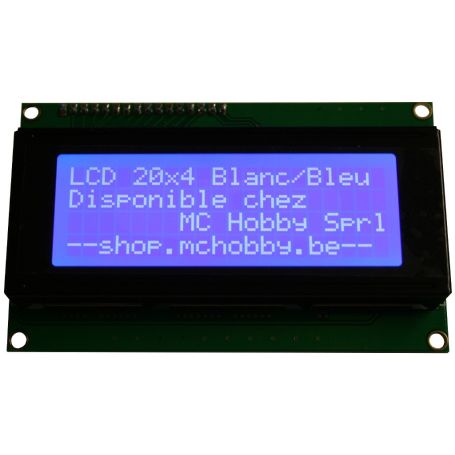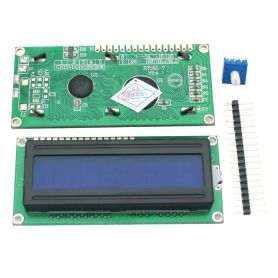LCD 20x4 + Backpack I2C. Blanc sur Bleu
LCD display
- 4 row of 20 characters
- I2C Backpack
- White over blue background.
- Arduino & MicroPython
Payments are secured by LyraCollect, a French payment collection company.
It is possible to delivered to your home, to a pick-up point or picked up by appointment at MCHobby
We prepare, pack and ship your orders with great respect and care.
A liquid crystal display with 20 chars x 4 lines over I2C bus
The HD44780 standard displays are really useful for creating stand-alone projects.
They can be interfaced easily with many microcontroller platforms such as Arduino, MicroPython, etc.
Here is a 20x4 white LCD screen on a blue background fitted with I2C LCD controller (a backpack)
The I2C backpack allows to control of an LCD display using only two SDA and SCL pins of the I2C bus (commonly A4 and A5 on Arduino). It is a very valuable tool given the number of pins required to operate these displays. If you did already connected several sensors to your platforms, wiring directly a LCD display to your microcontrôler can become a real headache ... the I2C breakout fitted on the display will save you a lot of work.
The great thing about the I2C bus is that you can have other I2C devices sharing the same bus (without consuming more pins). You can even use several I2C LCD displays on the same microcontroller by modifying its address on the bus (see the I2C bus address pins / jumper).
Learning to use a I2C LCD is a good Arduino/MicroPython project as well as a nice introduction to I2C. This will also be a nice tool for future projects.
Thanks to the LiquidCrystal_I2C Arduino library and lcdi2c MicroPython library, take the control over the LCD is a breeze (see the Tutorial section). The library will manage the I2C communication with the LCD display. Tested and approved by MCHobby.
Content
For each order, you will receive:
- The I2C controller assembled with the LCD (the "backpack")
- A 20 x 4 LCD display (20 characters per line)
Technical details of the backpack
- Interface: I2C
- I2C Address: 0x27 (by default, all jumper address removed)
- Pin identification: VCC,GND,SDA,SCL
- Drive the 16 pin LCD using a HD44780 driver (identical to the 2 lines white/blue display or a 4 lines display)
- Backlight
- Power: 5V
- Logic: 5V (the 3.3V microcontroleur must be 5V tolerant, eg: pyboard).
- Size: 27.7mm×42.6mm
- Contrast adjustement: potentiometer
- Interface I2C: only 2 signals SDA/SCL.
- Identical for 16x20 and 20x4 LCD
- Connector @ 2.54mm spacing (easy to use with Dupont wire)
Technical detail of LCD display
- 4 row of 20 characters each
- White text over Blue background
- Contains the english/japonese charset to display english/japanese text (see the HD44780 datasheet for mode information).
- Can have 8 extra charaters to créate extra Glyphs (mini-image), symbols or international charaters. See the MicroPython implementation.
Datasheet
- Document with the HD44780 commands (pdf)
Tutorials
- Wiki on the I2C LCD (DFRobot, English)
- Arduino I2C library (LiquidCrystal_I2C) 1602 LCD and example code.
- MicroPython LCDI2C library (GitHub, MCHobby)
Tested with Pyboard, 5V tolerant. Requires removal of the two gadgeteers transistors









![[T] - I2C Backpack for LCD LCD 16x2 + EXTRA. Blanc sur Bleu](https://shop.mchobby.be/2954-home_default/lcd-16x2-extra-blanc-sur-bleu.jpg)